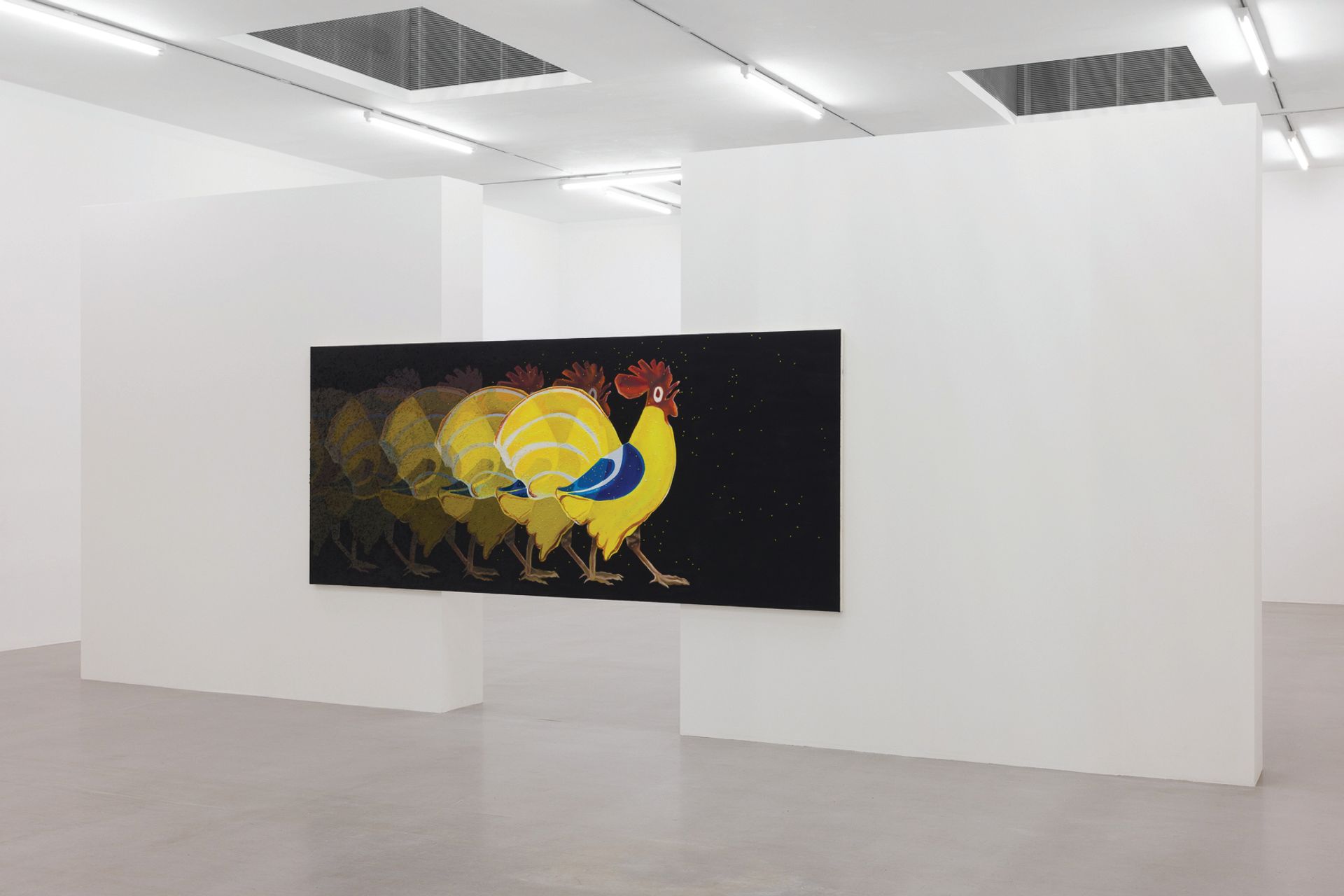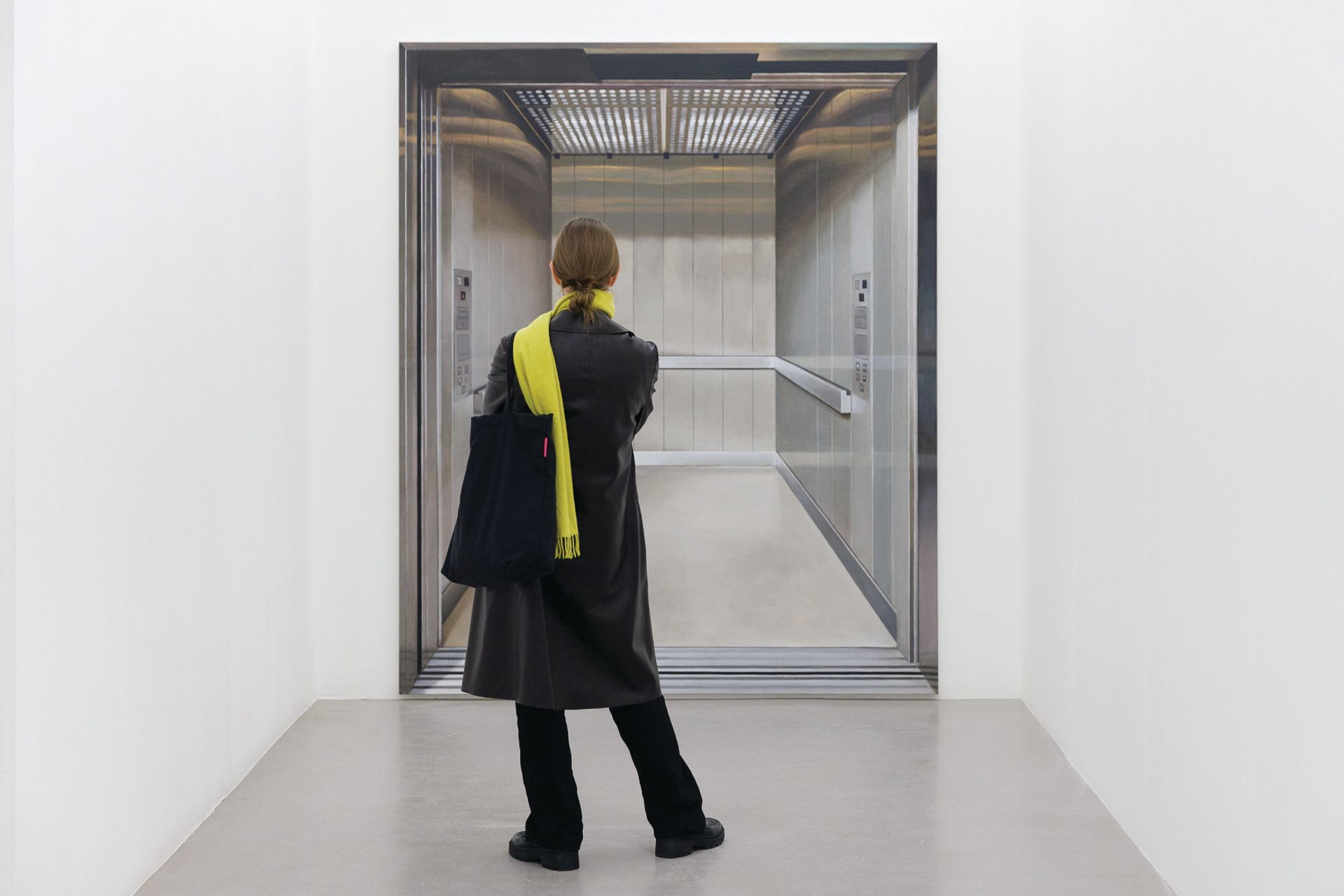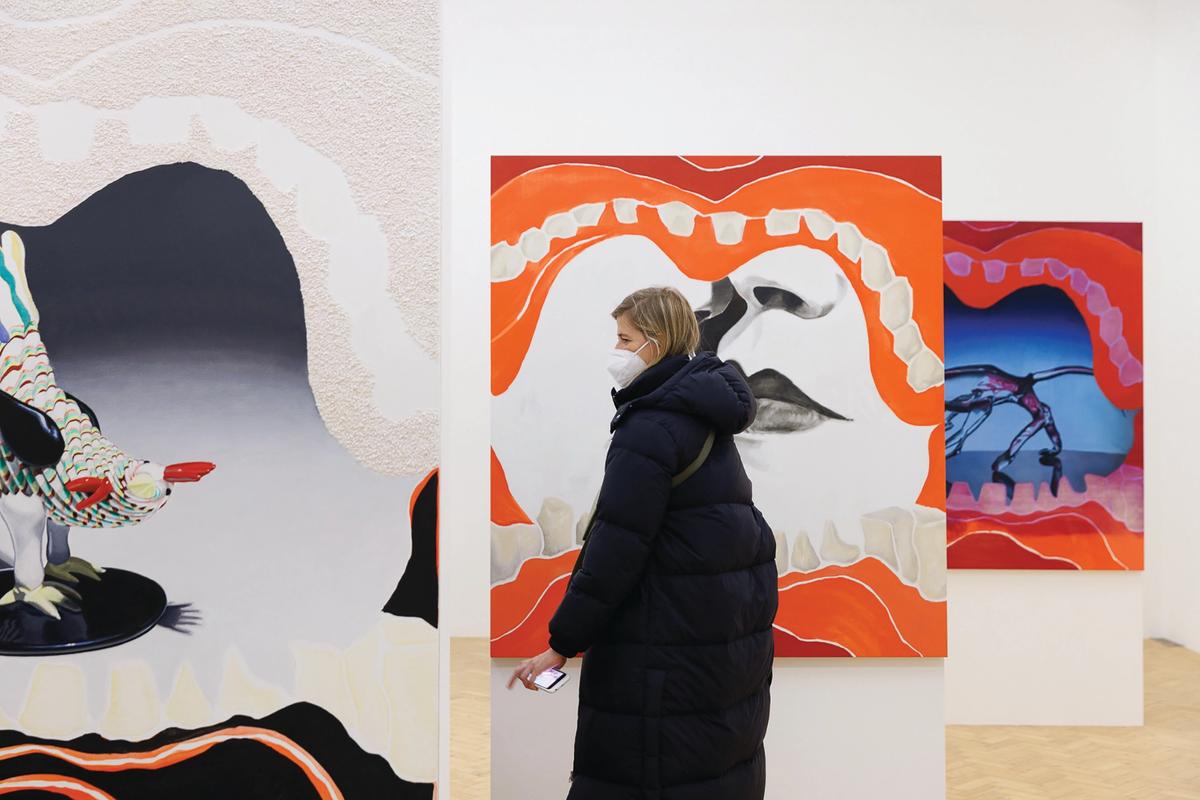Oink! Moo! Cluck! On a recent Sunday-afternoon stroll around the silent corporate precincts of the City of London, this was how a closed café advertised its meat and poultry dishes. Useful literalism, I suppose, targeted at a certain man-child clientele. But also a textual take on the familiar visual motif of a creature that peddles and consumes its own flesh: pig in a butcher’s apron, eager salmon with line and rod. There is a version of this reflexive oddity in the London-based Canadian artist Allison Katz’s current exhibition at Camden Art Centre—24 paintings and six digital-print posters. The Cockfather (2021) shows an elaborately feathered pottery egg container: a proud (or is it rueful?) cockerel that cranes its neck round at three eggs and three empty egg-holes in its flattened white back. Poor spatchcocked ceramic monster, immured (so it seems) in a sparkly black cavern.
Puffed up or pathetic, inherently comical in its masculine grandeur, the cock recurs in Katz’s paintings—it is practically a logo or trademark. At Camden, The Cockfather was tucked around a corner, while the first, large room in the show was dominated by The Other Side (2021): a rice-scattered black canvas in which a cartoonish yellow-and-blue bird repeats five times with more vivid insistence, as if speeding into view from left to right. The reference (title and image) is of course to a venerable, tiresome joke and its many variations: “Why did the chicken cross the road?” Frequently with Katz, everything starts with a scrap of language such as this—or something more high-toned. She is an artist for whom annotation, allusions, puns and other wordplay are essential, but somehow this does not quite distract from the strictly visual fascinations of her work.
Consider, for example, Katz’s approach to the self-portrait, which is always a matter of oblique invention rather than intimate confession. Letters and legends are all over the paintings, and frequently they denote the artist’s presence, but at some remove. Her initials, AK, become AKA: also known as. Her full name, Ms Allison Sarah Katz, gives the acronym MASK: which letters in turn compose a face in the self-consciously titled Akgraph (Tobias + Angel) (2021). The parenthetical reference is to Andrea del Verrocchio’s Tobias and the Angel (around 1470-75) in the National Gallery: a painting that appears here (but with its figures’ backs to us) as a pallid phantom presence behind Katz’s physiognomic signature. A question surfaces, here and in other paintings: where does handwriting end and drawing or painting begin? Image and word come together, drift apart, discover unexpected rhymes. Katz likes to quote Virginia Woolf, in Orlando, describing poetry as a “voice answering a voice”.

Installation view of Allison Katz: Artery at Camden Art Centre
Photo: Rob Harris
Street cred
Other modes of self-portrait: the autobiographical details that punctuate Posterchild (2021)—a painting based on an inter-war London Underground poster advertising the attractions of Hampstead. Katz noticed (she seems to attract these coincidences) that the street where she grew up in Montreal—Finchley Road, Hampstead—is also the exact address of Camden Art Centre. In Posterchild, the locations and the luminaries of London’s Hampstead (Keats, Blake, their respective abodes) are replaced by Katz’s childhood home, her baby nephew, a frowning Green Man panel, the quizzical Tobias again. The artist’s signature appears across two black-framed panels, executed in a script Katz has based on the graphic design of a 1968 Toulouse-Lautrec exhibition in Montreal. Also: a cockerel and a hen, crossing the road—because however “poetic” the connections Katz divines, they are usually rendered with a lightness edging towards the antic or absurd.
Puffed up or pathetic, inherently comical in its masculine grandeur, the cock recurs in Katz’s paintings—it is practically a logo or trademark.
Or into impure comedy. Given a room (almost) of their own are five of Katz’s funny and ferocious mouth paintings. These epiglottal perspectives are inspired by André Derain’s depiction, for a 1943 edition of Rabelais, of the view from inside Pantagruel’s mouth. Katz reproduces the tombstone teeth, tentacular facial hair, the pinks and reds of lips, gums and palate. These frame diverse scenes: a model cockerel with ice-cream sundae plumage, the gut-like twists and turns of a William N. Copley exhibition at Fondazione Prada, a portrait of Katz based on a Miu Miu campaign for which she modelled in spring/summer 2021. A jewelled tracksuit top, a nappa leather mini-bag in Cameo Beige: what seems luxe in the original photograph takes on here unexpected fleshy or encrusted aspects.
Slurp and clack
Which brings us to the corporeal qualities of paint in Katz’s work. For an art so attuned to the written word, or to the translation of verbal tics into imagery, it is also often bodily rather than in any fashion verbal. It took me an unconscionable age to think of the mouth paintings as having anything to do with speech, the slurp and clack of articulacy. They seem rather to be all gut feeling, expressed in queasy particulars of form and surface.
So too in Katz’s paintings of lone cabbages, which she has been making since 2013. Head, heart, capillaries: the shape and texture of the cabbage is horribly vulnerable, an organ sliced off at the stem. (I am guessing Katz knows that a coronary artery bypass graft is rendered in acronym as CABG/cabbage.) Above and to the right of each cabbage is the silhouette or shadow of a male head with glasses. Cabbage (and Philip) No. 22 (2020)—he is the artist’s partner, but it’s hard not to think of his as the face of the critic, flummoxed by the lonely brassica.
The five mouth paintings are shown in a chevron pattern, each on its own freestanding wall. On the reverse of each of these, a cabbage painting—cross the room and you go from ravenous overdetermination to small mundane enigma, something near but not exactly still-life. (The mouths, of course, are also gobbling the cabbages, and the Philips, like so many festive sprouts.) It is not the only playfully disorienting moment in Katz’s treatment of the rooms at Camden. In the biggest room, on the back of the gallery’s lift shaft, she has painted a trompe l’oeil lift interior, which it is genuinely easy, on entering, to take for the real thing. Walk towards it, back away again, and vertigo has as much to do with bodily intuition of the space behind, as a purely visual effect.

On the back of the gallery’s lift shaft, Katz has painted a trompe l’oeil lift interior
Photo: Rob Harris
If Katz is a connoisseur of connections and correspondences (what else is the title Artery except a declaration regarding energies and flows?), she is also an expert, profound and comical, in sheer painterly mystery. The neutral but minutely textured interior of a car, in Inhibition (2015); a stippling of sand or constellation of rice grains in many of the paintings; the jewellery appearance of the winged figure in CCTV (2020)—the last a variation on an earlier fairy theme. All of this to say: sometimes her ravishing surfaces refuse to let us in on the joke. Here is another favoured quotation of Katz’s, from the Brazilian novelist Clarice Lispector, who is describing the Sphinx: “I did not decipher her. But neither did she decipher me.”
Camden Art Centre, London, until 13 March
Curators // Sam Thorne, Nottingham Contemporary, and Martin Clark, Camden Art Centre
• Brian Dillon’s Essayism and Suppose a Sentence are published by Fitzcarraldo Editions. He is working on Affinities, a book mostly about photography


